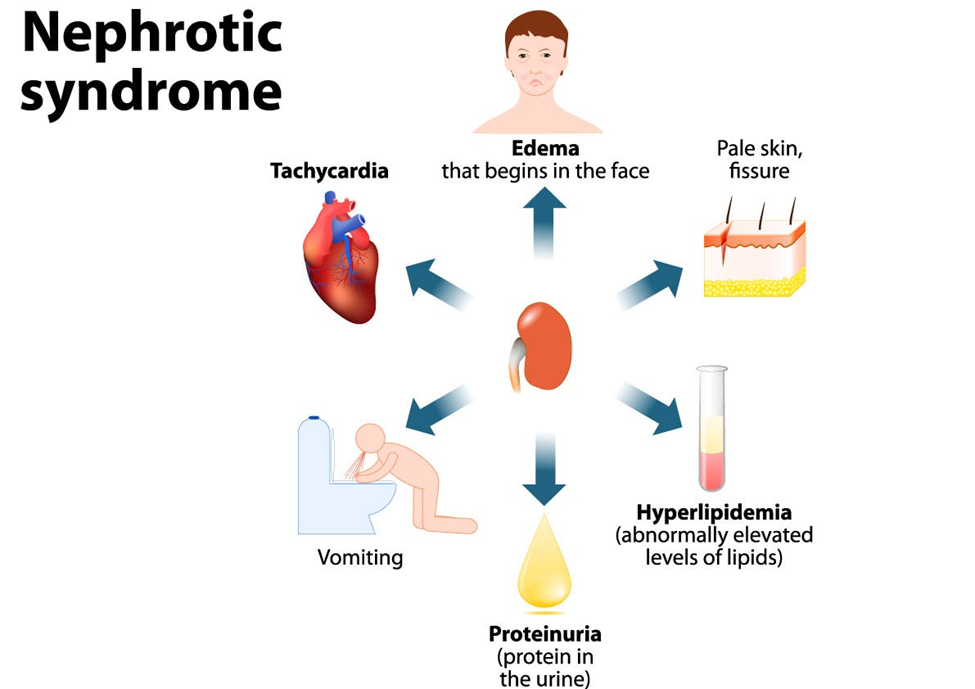A nurse is collecting data from a child who has nephrotic syndrome. Which of the following manifestations should the nurse expect?
Orange-tinged urine
Hypertension
Periorbital edema
Polyuria
The Correct Answer is C
A. Orange-tinged urine
- This manifestation is not typically associated with nephrotic syndrome. Orange-tinged urine may indicate other conditions such as dehydration, liver disease, or the presence of certain medications or foods.
B. Hypertension
- Hypertension is not a common manifestation of nephrotic syndrome. However, it can occur in some cases due to the retention of sodium and water, which can lead to fluid overload and increased blood pressure.
C. Periorbital edema
- This is a classic manifestation of nephrotic syndrome. Periorbital edema, or swelling around the eyes, is often one of the initial signs observed in children with nephrotic syndrome due to the loss of protein in the urine, leading to fluid accumulation in the tissues.
D. Polyuria
- Polyuria, or increased urine output, is not typically associated with nephrotic syndrome. Instead, children with nephrotic syndrome may experience oliguria or normal urine output, depending on the severity of renal involvement and fluid balance.

Nursing Test Bank
Naxlex Comprehensive Predictor Exams
Related Questions
Correct Answer is B
Explanation
A. Place new linen on the client's bed every other day: While changing linen regularly is important for maintaining cleanliness and preventing infection, waiting every other day may not be sufficient for a client with burns, especially if there is wound drainage or soiling. Linens should be changed more frequently, ideally daily or as needed, to ensure cleanliness and prevent the spread of infection.
B. Change gloves between sites when providing wound care to multiple wounds: This is a correct action. Changing gloves between sites when providing wound care helps prevent the spread of infection from one wound to another. It reduces the risk of cross-contamination and helps maintain a sterile environment during wound care procedures.
C. Change the dressing on infected wounds first: This is incorrect. Dressings on infected wounds should be changed promptly to prevent the spread of infection. However, changing the dressing on infected wounds first may lead to contamination of other wound sites if proper precautions are not taken. It's important to follow proper infection control procedures, including changing gloves between wound sites and using aseptic technique.
D. Monitor vital signs every 4 hr: Monitoring vital signs is important for assessing the client's overall condition, but it is not directly related to preventing infection. Vital signs may indicate signs of infection, such as fever or increased heart rate, but they do not prevent infection on their own. Other measures, such as wound care and infection control practices, are more directly related to preventing infection in clients with burns.
Correct Answer is A
Explanation
A. "My belly doesn't hurt anymore."
- This statement is concerning because sudden relief from severe right lower quadrant pain in a child with a history of nausea, vomiting, and suspected appendicitis may indicate a rupture or perforation of the appendix. When the appendix ruptures, there may be a temporary alleviation of pain due to the release of pressure. However, this situation is critical and requires immediate medical attention to prevent further complications such as peritonitis or sepsis.
B. "I am hungry and thirsty."
- While it's normal for a child to feel hungry and thirsty, especially if they have been experiencing nausea and vomiting, this statement is not necessarily concerning on its own. However, in the context of suspected appendicitis and severe right lower quadrant pain, it's important for the child to remain NPO (nothing by mouth) to prevent complications in case surgery is needed.
C. "I'm tired and want to take a nap."
- Feeling tired and wanting to rest is not uncommon, especially if the child has been experiencing discomfort or pain for a prolonged period. While this statement may indicate fatigue, it's not inherently concerning in the context of suspected appendicitis. However, it's important for the nurse to monitor the child's energy level and overall condition.
D. "I am scared and I want to go home."
- It's understandable for a child to feel scared or anxious, particularly when facing a medical procedure such as surgery. While this statement reflects the child's emotions, it doesn't necessarily indicate a change in their medical condition. However, it's important for the nurse to address the child's fears and provide emotional support while ensuring that the child receives appropriate medical care.
Whether you are a student looking to ace your exams or a practicing nurse seeking to enhance your expertise , our nursing education contents will empower you with the confidence and competence to make a difference in the lives of patients and become a respected leader in the healthcare field.
Visit Naxlex, invest in your future and unlock endless possibilities with our unparalleled nursing education contents today
Report Wrong Answer on the Current Question
Do you disagree with the answer? If yes, what is your expected answer? Explain.
Kindly be descriptive with the issue you are facing.
